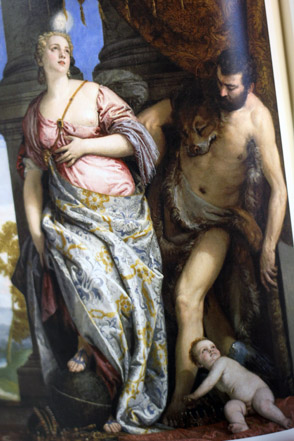Title: The Apocrypha
Author: David Daniell (trans)
Publisher: The Folio Society, 2006. Out of print.
Condition: Hardcover, leather spine with boards. With decorative slipcase. In very good condition overall, slight shelf wear to slipcase. Huge book, 12 x 9.1 x 1.7 inches, 351 pages.
Translated out of the Greek and Latin Tongues
Being the Version Set Forth AD 1611
Compared with the Most Ancient
Authorities and Revised AD 1894
About the book (from the publisher):
Powerful narratives of virtue and vice, heroism and betrayal; magisterial, haunting verse; unique insights to a nation’s history of battle and endurance; moving prayers; heroic deeds.
The Apocrypha contains some of the best-known stories in the Bible – stories which have captured the popular imagination and sunk deep into our cultural consciousness, permeating music, literature and art.
When St Jerome compiled the Vulgate version of the Old Testament, he marked certain passages which were found in Greek, but not older Hebrew collections, as ‘Apocrypha’, meaning ‘hidden’. Powerful narratives of virtue and vice, heroism and betrayal; magisterial, haunting verse; unique insights to a nation’s history of battle and endurance; moving prayers; heroic deeds … These fifteen books would become a key source of controversy as theologians squabbled over their place or inclusion in the Bible.
Whatever their authority, they are works of transcendent beauty – the language gorgeous, the stories thrilling. The poetry and prayer of ‘The Wisdom of Solomon’ and ‘Ecclesiasticus’ are an integral part of our culture. The hymn of praise in ‘The Song of the Three Holy Children’, not only entered the Christian Liturgy, but formed the central core of Benjamin Britten’s opera, The Burning Fiery Furnace. Freud chose the story of ‘Judith and Holofernes’ as symbolising the ‘castration complex’, while many of our proverbs, still in daily use, come directly from the Apocrypha.
To painters, they proved irresistible subject matter. The Old Masters returned again and again to the books of the Apocrypha for inspiration. The thirteen interpretations selected to illustrate this new edition span the breadth of the period and reveal its stylistic development. They include Artemisia Gentileschi’s Susanna and the Elders, Tintoretto’s Creation of the Animals, Ruben’s Triumph of Judas Maccabeus. Placed side by side with the text, these luminous artworks become doubly powerful.
It is a tangled history that few scholars could explain with the clarity and authority of Professor David Daniell, whose insightful introduction was commissioned specially for The Folio Society. This magnificent edition brings the fifteen books together in one volume. Quarter-bound in goatskin leather and moiré silk, and illustrated with a selection of paintings from the Old Masters, and comes as shown with the slipcase illustration: “Jeremiah Lamenting the Destruction of Jerusalem”, by Rembrandt van Rijn, ca 1630.







